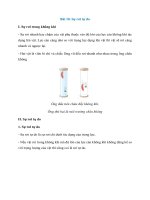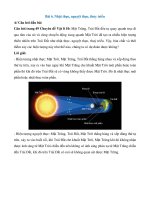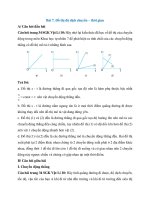Advanced Computer Networks: Lecture 8 - Dr. Amir Qayyum
Bạn đang xem bản rút gọn của tài liệu. Xem và tải ngay bản đầy đủ của tài liệu tại đây (385.71 KB, 34 trang )
CS716
Advanced Computer Networks
By Dr. Amir Qayyum
1
Lecture No. 8
Reliable Transmission
• Higher level of abstraction (transport layer vs. data
link layer)
my
computer’s
name
is
my
machine
my
machine
client
mail.yahoo.com
computer’s
is
mymachine
server
3
Reliable Transmission
• Higher level of abstraction (transport layer vs. data
link layer
my
computer’s
name
is
my
machine
my
machine
client
mail.yahoo.com
my
machine
is
my
computer’s
name
server
4
Reliable Transmission
• Errorcorrecting codes are not advanced
enough to handle the range of bit and burst
errors
– Corrupt frames generally must be discarded
– A reliable linklevel protocol must recover
from discarded frames
• Goals for reliable transmission
– Make channel appear reliable
– Maintain packet order (usually)
– Impose low overhead / allow full use of link
5
Reliable Transmission
• Reliability accomplished using
acknowledgments and timeouts
– ACK is a small control frame
confirming reception of an earlier frame
– Having no ACK, sender retransmits after
a timeout
6
Reliable Transmission
• Automatic Repeat reQuest (ARQ)
algorithms
– Stopandwait
– Concurrent logical channels
– Sliding window
• Gobackn, or selective repeat
• Alternative: forward error correction
(FEC)
7
Automatic Repeat reQuest
• Acknowledgement (ACK)
– Receiver tells sender when frame received
– Cumulative ACK (used by TCP): have
received specified frame and all previous
– Selective ACK (SACK): specifies set of
frames received
– Negative ACK (NACK or NAK): receiver
refuses to accept frame now, e. g. , when
out of buffer space
8
Automatic Repeat reQuest
• Timeout: sender decides that frame
was lost and tries again
• ARQ also called Positive
Acknowledgement with
Retransmission (PAR)
9
StopandWait
• Send a single frame
• Wait for ACK or timeout
– If ACK received, continue with next frame
– If timeout occurred, send again (and wait)
• Frame lost in transit; or corrupted and discarded
Frame 0
Sender
ACK0
Receiver
Frame1
ACK1
10
Acknowledgments and Timeouts
Sender
Receiver
Timeout
Timeout
Timeout
Receiver
(a)
(c)
Receiver
Sender
Receiver
Timeout
Timeout
Timeout
Sender
Timeout
Time
Sender
(b)
(d)
11
StopandWait
• If receiver receives a frame
correctly, but sender receives the
ACK after timeout …
– Sender resends the frame; how the
receiver knows it’s the same frame or
the next frame ?
12
StopandWait
• Requires frame identification
– Duplicate frame ?
– Duplicate ACK ?
– 1 bit is enough (if physical network
maintains order)
• sender tracks frame ID to send
• receiver tracks next frame ID
expected
13
StopandWait State Diagram
send: 0
expect: 0
receive
frame 0
receive frame 0 /
receive ACK 1
receive
ACK 0
receive
ACK 1
send: 1
expect: 0
send: 0
expect: 1
receive
frame 1
send: 1
expect: 1
14
StopandWait
• Frames delivered reliably and in order
• Is that enough ?
– No, we need performance, too.
• Problem: keeping the pipe full … ?
• Example
– 1.5Mbps link x 45ms RTT = 67.5Kb (~8KB)
– 1KB frames implies 182 Kbps (1/8th link utilization)
– Want the sender to transmit 8 frames before waiting
for ACK
– Throughput remains 182 Kbps regardless of the link
bandwidth !!
15
Concurrent Logical Channels
• Multiplex several logical channels over a single
ptop physical link (include channel ID in
header)
• Use stopandwait for each logical channel
• Maintain three bits of state for each logical
channel:
– Boolean saying whether channel is currently busy
– Sequence number for frames sent on this channel
– Next sequence number to expect on this channel
• ARPANET IMPIMP supported 8 logical
16
Concurrent Logical Channels
• Header for each frame include 3bit
channel number and 1bit sequence
number
– Same number of bits (4) as the sliding
window requires to support up to 8
outstanding frames on the link
17
Concurrent Logical Channels
• Characteristics
– Separates reliability from flow control and
frame order
– Each channel limited by stopandwait
bandwidth
– Aggregate bandwidth uses full physical link
– Supports multiple communicating processes
– Can use more than one channel per process
• But no frame ordering between channels
18
Approaches for Reliable
Transmission …
• Stop and wait
– Provides reliable, inorder delivery
– Sacrifices performance
• Multiple logical channels
– Provides reliable delivery at full link bandwidth
– Sacrifices packet ordering
• Sliding window: meets all three goals
19
Sliding Window
…
Sender
Receiver
…
Time
• Allow sender to transmit multiple frames before
receiving an ACK, thereby keeping the pipe full
• Upper bound on outstanding unACKed frames
• Also used at the transport layer (by TCP)
20
Sliding Window Concepts
• consider ordered stream of data
– broken into frames
– stopandwait
• window of one frame
• slides along stream over time
time
• sliding window algorithms generalize this notion
– multipleframe send window
– multipleframe receive window
21
Sliding Window Concepts
• send window
– fixed length, containing numbered frames
– starts at earliest unacknowledged frame
– only frames in window sent over network
time
– Green: sent and acknowledged
– Red: sent (or can be sent) but not acknowledged
– Blue: available, but not within send window
22
Sliding Window Concepts
• receive window
– fixed length (unrelated to send window)
– starts at earliest unreceived frame
– only frames in window are buffered
time
– Green: received and delivered
– Red: received and buffered
– Blue: received and discarded
23
Sliding Window Sender
• Assign sequence number to each frame (SeqNum)
• Maintain three state variables:
– send window size (SWS)
– last acknowledgment received (LAR)
– last frame sent (LFS)
• Maintain invariant: LFS LAR ≤ SWS
LAR=13
11
12
13
14
15
16
time
LFS=18
≤ SWS
17
18
19
20
• Advance LAR when ACK arrives
• Buffer up to SWS frames and associate timeouts
24
Sliding Window Receiver
• Maintain three state variables
– receive window size (RWS)
– largest frame acceptable (LFA)
– next frame expected (NFE)
• Maintain invariant: LFA – NFE+1 ≤ RWS
NFE=13 ≤ RWS
LFA=17
11
12
13
14
15
16
17
18
19
time
20
• Frame SeqNum arrives:
– if NFE ≤ SeqNum ≤ LFA accept
– if SeqNum ≤ NFE or SeqNum > LFA discarded
• Send cumulative ACKs
25


